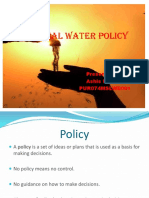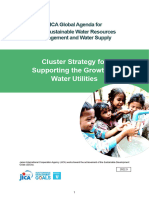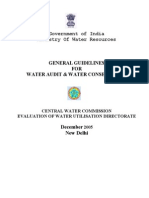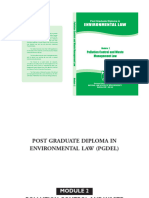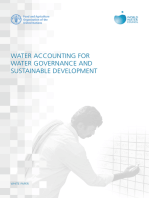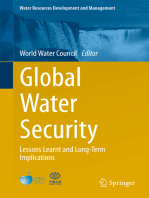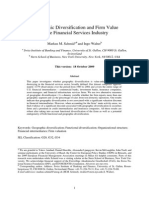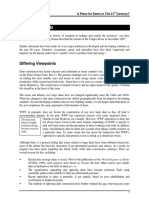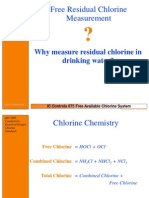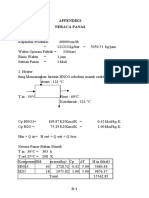A National Water Demand Management Policy in Jordan
A National Water Demand Management Policy in Jordan
Uploaded by
Tony BuCopyright:
Available Formats
A National Water Demand Management Policy in Jordan
A National Water Demand Management Policy in Jordan
Uploaded by
Tony BuOriginal Description:
Original Title
Copyright
Available Formats
Share this document
Did you find this document useful?
Is this content inappropriate?
Copyright:
Available Formats
A National Water Demand Management Policy in Jordan
A National Water Demand Management Policy in Jordan
Uploaded by
Tony BuCopyright:
Available Formats
The current issue and full text archive of this journal is available at www.emeraldinsight.com/1477-7835.
htm
MEQ 17,2
A national water demand management policy in Jordan
Rania A. Abdel Khaleq
Ministry of Water and Irrigation, Amman, Jordan, and
216
Benedykt Dziegielewski
International Water Resources Association, Southern Illinois University, Carbondale, Illinois, USA
Abstract
Purpose The purpose of this paper is to present a proposal for formulating a national water demand management policy for Jordan. The objective is to stimulate discussion on the development and adoption of a formal policy document. Design/methodology/approach The paper reviews data on water availability and use in Jordan. This is followed by a discussion of a number of policy objectives and elements. Findings The paper results in the formulation of a policy that should be further reviewed and made ofcial by the Ministry of Water and Irrigation in Jordan. Originality/value The paper is a new source of information on the necessary elements of water policy. Keywords Water supply, Jordan Paper type General review
Management of Environmental Quality: An International Journal Vol. 17 No. 2, 2006 pp. 216-225 q Emerald Group Publishing Limited 1477-7835 DOI 10.1108/14777830610650528
Introduction Jordan is a semi arid country with very limited freshwater resources. The availability of water is classied as very low on the Water Stress Index, which indicates the degree of water shortage or scarcity. Water Stress Index is the value of annual rainfall divided by the total population (m3/capita/year). Countries with less than 1,700 m3/capita/year are regarded as countries with existing stress, while countries with less than 1,000 m3/capita/year are regarded as having scarcity and countries with less than 500 m3/capita/year are regarded as having absolute scarcity. With 167 m3/capita/year Jordan falls into the category of absolute scarcity (Yachiyo Engineering Co., 2001). The spatial distribution of rainfall in Jordan is shown on Figure 1. In 2002, the total use of water in Jordan was 809.8 million cubic meters (MCM) or 159 m3/capita/year at the total 2002 countrys population of 5.1 million people. This usage included 88.8 MCM of nonrenewable groundwater (groundwater mining) and 72.4 MCM of treated wastewater. The total renewable freshwater resources in Jordan are estimated at 850 MCM or 167 m3/capita/year, however the presence of groundwater mining and wastewater reuse in 2002 indicates that the demand already exceeds the availability of renewable water during that year. Table I shows the most recent statistical data on water use in Jordan by user sector and water source. The Kingdom of Jordan is facing an unremitting imbalance between the total sectoral water demands and the available supply of freshwater. By 2020, the total demand for water is expected to increase to 1,685 MCM because of the large increases in population, improvements in living standards and growth in economic activity.
Water demand management
217
Figure 1. Spatial distribution of rainfall in Jordan
Sector Municipal Industrial Irrigation Livestock Total
Surface water 50.540 1.863 156.950 6.000 215.353
Groundwater 198.685 34.971 287.556 0.835 522.047
Treated wastewater 0.000 0.000 72.365 0.000 72.365
Total water use 249.225 36.384 516.871 6.835 809.765 Table I. Sources of sectoral water use in Jordan in 2002 (in million cubic meters per year, MCM/year)
While the new sources of water supply are expected to increase the available water from the current level of 850 MCM per year to 1,289 MCM per year by 2020, a shortfall of 396 MCM representing 24 percent of total demand will remain and will have to be managed through appropriate demand-reduction programs. Current approaches towards water resources management tend to be supply driven; meaning that whenever there is a shortage, the solution usually involves the
MEQ 17,2
218
capital investment in new water supply projects. A shift from the traditional supply orientated approach towards one of water conservation and demand management is essential for the sustainability of water resources and the environment, as well as economic efciency and social development. However, the move towards more integrated demand and supply approach takes a great deal of time, effort and commitment and is currently backed by key players at many levels in the institutional and political spectra (WMO/DFID/Unesco, 1999). Demand management approach differs from supply-oriented approach by placing more emphasis on social and economic uses to which water is put (Environment Canada, 1990). When used with current water supply management approaches, water demand management offers the prospect of greatly improved water management in comparison to its present status. Water demand management policy for Jordan needs to be developed to provide a framework for water demand management programs. In order to address some of Jordans water problems, a National Water Strategy was developed and approved in 1997. Water demand management is currently a part of the Water Strategy for Jordan (Hashimite Kingdom of Jordan-Ministry of Water and Irrigation, 1997), which states that resource management shall continually aim at achieving the highest possible efciency in the conveyance, distribution, application and use of water resources. Among the 47 recommendations contained in the Strategy were the following ve which pertain to water demand management: (1) priority of 100 liters per capita per day for basic human needs; (2) creation of a national water data bank; (3) full utilization of all wastewater for irrigation purposes; (4) full but sustainable development of aquifer resources; and (5) adoption of a ve-year resource development plan. In the demand management and conservation area, the Water Strategy cites the following four activities: (1) achievement of the highest possible efciency in water conveyance, distribution and use; (2) adoption of measures to maximize the net benet from the use of a unit ow of water; (3) denition and assignment of roles in water conservation to be played by the different sectors of society; and (4) promotion of water saving systems and devices. Although the Strategy does not identify any specic demand management programs, it is clear that the Ministry of Water and Irrigation supports the implementation of demand management efforts as a necessary part of the long-term solution to Jordans water shortages. A Water Resources Management Plan has been developed for Jordan in 2001 (Yachiyo Engineering Co., 2001). The plan examined conventional and non-conventional water resources and discussed quantitative and qualitative
management issues, as well as institutional and regulatory issues. The plan concluded that the gap between demand and the available water supplies will continue to exist, even after implementing the plans provisions for enhancing and expanding supplies. The urban water demand management policy includes several programs: . a program to promote a recognized industry for water efcient products; . setting national product standards and information; . modifying building codes to increase water use efciency; . a training program for managers and operators; . a program for peak demand reduction; . a national program of audits for large consumers; . an arid landscaping program; . a program to promote rainwater use and a gray water reuse program for areas with no sewerage; and . a public awareness program to achieve long term awareness and change in attitudes of water users. In addition, there are policies which aim at the reduction of unaccounted for water. The industrial water demand management policy includes the use of economic instruments for pollution control and technological changes. The policy also recommends using public education as a way to increase understanding about water scarcity. Additionally, comprehensive research activities and data collection programs are of critical importance to support all policies and are part of the water management activity at the national level. Other initiatives also aim at improving equitability of accesses through a nancial assistance program. Policies for irrigated agriculture, which is the largest user of water in Jordan, are being formulated by the Ministry of Agriculture and are not reviewed in this paper.
Water demand management
219
A proposed water demand management policy for Jordan As mentioned above, the Ministry of Water and Irrigation developed a Water Strategy for Jordan and several specic policies, which include: . Water Utility Policy; . Irrigation Water Policy; . Wastewater Management Policy; and . Groundwater Management Policy. The reminder of this article describes a suggested Water Demand Management Policy that could be developed to supplement the already existing policies. Its format follows the format of the existing four policies, which are published on the website of the Ministry of Water and Irrigation (www.mwi.gov.jo/Misc/Misc.aspx).
MEQ 17,2
220
Policy statement The long-term National Water Demand Management Policy of Jordan is aimed at inuencing and controlling water demand and water usage to achieve a better utilization of the available water resources while meeting the objectives of social and economic development of the country and creating positive environmental impacts. The National WDM Policy is consistent with the Water Strategy of the Kingdom and conforms to its long-term objectives. While the policy is national, it is being implemented by Governmental agencies with the primary responsibilities being vested in the Ministry of Water and Irrigation. Specic policy considerations The Water Demand Management Policy of the Hashemite Kingdom of Jordan addresses the management of water demands in all sectors of the Jordans economy including residential, industry, tourism, agriculture and other activities of national importance. Many provisions of this policy are already in practice. Specic statements address the following ten specic policy considerations: (1) Universal Water Metering and Loss Control (involving tracking of water ows throughout water transmission, treatment and distribution systems with a goal to identify and repair water leaks and increase the proportion of water that is metered and billed to residential, commercial, industrial and public sector users of water). (2) Fullling Unserved Water Demands (e.g. with a near-term goal to satisfy the presently unmet demands in municipal and industrial uses including the additional water needs of educational institutions and water that is required to support tourism. This goal will be accomplished not only by using the new sources of water, but also by using water savings that are achieved through the ongoing water demand management and water conservation and loss reduction programs, in addition to water recycling). (3) National Plumbing Standards and Water Conservation Codes (primarily the development of a National Plumbing Code including the implementation of National Plumbing Standards with acceptable safety and quality requirements to ensure that all plumbing products are certied thus preventing the inferior products that quickly deteriorate and cause leaks, or products that are made of inferior materials but are sold as high grade from entering the market in Jordan). (4) Water Pricing and Cost Recovery (e.g. structuring the municipal water and wastewater tariffs to include price incentives for water conservation and setting the price levels to recover the cost of operation and maintenance and the costs of the ongoing necessary capital improvements in water supply systems). (5) Comprehensive Water-Use Information Program (e.g. development and maintenance of a comprehensive national inventory of all water withdrawals and uses, which is essential for understanding the effects of spatial and temporal patterns of water use on the quality, availability and sustainable use of existing water resources).
(6) Public Awareness and Education (that is consistent with the Water Strategy for Jordan; an ongoing public information and education program is needed to increase and maintain high levels of public awareness of the importance of water for the well-being of the country and its future economic and social development). (7) Best Management Conservation Practices (e.g. establishing a list of water demand best management practices, or BMPs, to be coordinated and implemented by the WDMU at the Ministry of Water and Irrigation). (8) Public Buildings Efciency Improvement Program (e.g. retrot of non-conserving plumbing xtures in all governmental, public and commercial buildings). (9) Water Demand Management Research and Development (e.g. special studies on water use in the municipal, industrial, agricultural and other sectors to support and guide the ongoing water demand management policies and programs). (10) Recognition of Individuals, Institutions and Industry for Advancement in Water Efciency (with an aim to establish an Annual Water Drop Award to recognize individuals, institutions and other entities for their contribution to the improvements in water-use efciency in Jordan). Other aspects of WDM policy will need to address a number of legislative initiatives and institutional arrangements for the development and implementation of water demand management policies and programs. The proposed WDM Policy for Jordan will be disseminated among the water management organizations and the general population of the Kingdom by developing a number of specic Policy Statements. The following section denes some of the statements on specic issues in water demand management.
Water demand management
221
Policy statements In terms of its main objective, the National Water Demand Management Policy aims at a maximum utilization of water and diminishing water waste and promoting water use efciency and water conservation, while maintaining the social and economic benets of water use, and creating positive environmental impacts. The National WDM Policy includes the following statements which provide guidance for the development and implementation of demand management measures and programs in all sectors and regions of the country: On the role of water demand management
The idea of water conservation is not new to Jordan because in this region of low rainfall the people had to survive by harvesting rainwater and minimizing their water usage. This behavior has continued until modern times as the recent survey data indicate that nearly two thirds of the households in Amman and one third in rural areas of Jordan reuse water within the household.
MEQ 17,2
Given the general scarcity of freshwater in the region, water demand management and water conservation will continue to play an important role in achieving sustainable use of freshwater resources in Jordan.
On the unserved water demand
222
Because of the chronic shortages of water and the low efciency of water supply and distribution systems, the actual use of water by many users in the urban and rural areas of the country is below the internationally established targets of daily per capita usage. On average, the residential water demand may be 30 to 50 percent below the total demand, which includes the actual use and the currently unserved demand. Water savings that will be achieved through the implementation of water conservation programs will be an important source of additional water to meet the unserved demands.
On codes and standards
The new Codes for buildings in Jordan include standards for showerheads, faucets, and water closets. These standards specify the maximum water use in liters per minute or liters per ush for all plumbing xtures that are installed in newly constructed buildings. The water-efcient plumbing xtures mandated by the Jordans Plumbing Code will reduce national water demand and wastewater ows over time due to the installation of these xtures in new construction and also a gradual voluntary replacement of the older less efcient xtures with the Plumbing Code-compliant models. Updating and adjusting current building codes to increase water use efciency is an important activity of the National water demand management program. The availability and consumer adoption of water efcient xtures and water-efcient appliances such as dishwashers and washing machines will also have a signicant impact on future water use without requiring any signicant changes in water-using behavior or diminishing the basic functions of this equipment. The resultant water savings will provide monetary savings in the necessary investments on water supply and wastewater disposal. The adoption of water-efcient appliances will also achieve savings in energy use. At present, plumbing products sold and used in Jordan (such as pipes, valves, tools, and other materials) do not have to go through a certication for product quality standards. In some cases, inferior products that quickly deteriorate and cause leaks, or products that are made of inferior materials and sold as high grade. A Plumbing Product Certication Program through Daman at the Jordan Institute for Standards and Measures (JISM) could potentially save large quantities of water by eliminating water leakage in households if the quality of plumbing and plumbing products was improved. Once the certication program is approved then there will be need to remove non-compliant sanitary ware from the market possibly after a one-year grace period.
An important activity of water demand management is to promote recognized industry for water efcient products and water saving devices. On universal water metering and loss control
Given the water situation in the Kingdom, it is important to increase the proportion of municipal water that is metered and billed to residential, commercial, industrial, and public sector users. Universal metering of water use is part of the National Water Strategy. It is also important to identify and repair all water leaks in the distribution system.
Reduction of non-revenue water and water loss is of critical importance. This can be achieved through investment in leak detection and repair programs and replacement of old and deteriorated transmission and distribution pipelines.
Water demand management
On peak demand reduction
Previous experiences in other countries showed that demand reduction programs could reduce peak day demand by up to 20 percent. The reduction of peak demands will become more important as more urban areas in Jordan receive continuous supply of water.
223
On water pricing and cost recovery
The municipal water and wastewater tariffs in Jordan provide important economic incentives for water conservation. The tariffs are structured to discourage high water use by charging higher prices at higher quantities of water use. Also by setting the price levels to recover the cost of operation and maintenance and also the costs of the ongoing capital improvements in water supply systems provides an additional incentive for efcient use of water. Further development and evaluation of conservation-oriented water tariffs for both municipal and agricultural uses of water is being undertaken by the MWI.
On water supply augmentation using rainwater harvesting and/or grey water or other recycled water
Rainwater harvesting for domestic purposes in urban and rural areas can provide a non-potable water source than can augment the existing water supplies.Certain potable water may be replaced with recycled water. Home gardens in areas with no sewerage systems can be irrigated with gray water, which is collected from water used in sinks, showers, bathtubs, oor drains, washing machines, and dish washing machines. Although lower in quality, the gray water is less contaminated than toilet water. It can be easily treated on site and reused for non-potable uses such as garden irrigation. This will help reduce house demand on fresh water. Regulations need to be developed in this regard to examine any health hazards that can be associated with gray water reuse.
On comprehensive water-use information program
The MWI has begun the development and maintenance of a comprehensive national inventory of water withdrawals and uses (see Table I). The National data on water use are needed for the protection and monitoring of freshwater resources of the Kingdom (especially to assess stress on rivers and aquifers) and to assess the availability of water resources to support the population and economic growth of the country. Reliable estimates of water use are essential for understanding the effects of spatial and temporal patterns of water use on the quality, availability and sustainable use of existing water resources.
On public awareness and education
Consistent with the Water Strategy for Jordan, an ongoing public information and school education program is needed to increase and maintain high levels of public awareness of the importance of water for the well-being of the country and its economic and social development. The WDM Policy ensures that public education continues through a xed program that uses a variety of measures including the relevant messages and media. Periodic
MEQ 17,2
survey of public opinion on adoption of water conservation measures will be conducted to assess and enhance the educational program.
On implementation of water demand management programs
224
The Ministry of Water and Irrigation will continue to play a leading role in the development and implementation of WDM programs and appropriate water efciency measures. The WDM Unit at the Ministry is undertaking some nationwide demand-reduction programs. These include audits of large water consumers and a public buildings efciency improvement program (i.e. retrot of nonconserving plumbing xtures in buildings), in addition to an arid landscaping program and a best management conservation practices program, which establishes a list of water demand management practices BMPs to be coordinated by the WDMU.
On industrial water demands
The industrial sector is gaining more importance in Jordan with the Government working on creating an investment environment favorable to increase the contribution of this sector to the national economy. To meet the growing industrial water demands, industries are encouraged to recycle water within the industrial facility, use of lower quality water wherever possible, reuse of treated wastewater in the industrial process wherever possible and adoption of technology that uses less water for the same industrial product. Economic instruments for pollution control are also important in this regard.
On tourist water demands
Tourism is also gaining importance in Jordan and contributing signicantly to the national economy. Programs for the hotel industry about water scarcity are important. Parallel with water audits are retrots of hotel buildings with water saving technologies. Awareness programs that target tourists should also be considered.
On improving equitability of access though nancial assistance
To promote and affect a transition towards water demand management, nancial assistance program shall be continued to less privileged communities. This is important because this transition will have some cost on water users that might be prohibitive.
On training and capacity building
A water demand management-training program for all stakeholders at the water sector forms an integral part for a water demand management strategy. The WDMU at MWI will develop a training program and offer training courses on annual or even more frequent basis.
On water demand management research and development
The WDM Unit and the MWI is undertaking special studies of water use in the municipal, industrial, agricultural and other sectors. The purpose of these studies is to support and guide the ongoing water demand management policies and programs in the country.
A competitive long-term research program on water demand management needs to be undertaken by the Ministry of Water and Irrigation in collaboration with the major universities and research institutes in Jordan.
Water demand management
On national recognition of WDM accomplishments
The importance of WDM in Jordan justies the establishment of annual awards to industrial rms, institutions and individuals for their accomplishments in achieving greater efciency of water use or making notable contributions to the scientic underpinnings and practical implementation of water demand management.
225
Conclusions The preliminary water demand management policy presented here will need to be reviewed by a higher committee at the Ministry of Water and Irrigation. If approved, it will be forwarded to the Council of Ministers to be debated and approved as part of the national water policies. However, it is important to realize that in Jordan there is no alternative to demand management and conditions will dictate what water demand management programs will be needed until added supplies can be identied and used. The proposed demand management measures will focus on water conservation practices to make better use of limited supplies, but do not mean a decline in quality of service provided but rather on a more efcient approach to satisfying water demands. However, to be accepted easily by the public, water demand management measures should arise from good planning rather than be imposed on an ad hoc basis during a water shortage crisis management situation.
References Environment Canada (1990), Water Demand Management in Canada: A State-of-the-Art Review, Social Science Series No. 23, Inland Waters Directorate, Water Planning and Management Branch, Ottawa. Hashimite Kingdom of Jordan Ministry of Water and Irrigation (1997), Jordans Water Strategy, Ministry of Water and Irrigation, Amman. WMO/DFID/Unesco (1999), Tools for Water Use and Demand Management: A Workshop, Harare, available at: www.nwl.ac.uk/ih/www/research/bdemandman.html. Yachiyo Engineering Co. (2001), The Study on Water Resources Management in the Hashimite Kingdom of Jordan, Japan International Cooperation Agency and Ministry of Water Irrigation, Amman. Corresponding author Rania A. Abdel Khaleq can be contacted at: Rania_Abdel_Khaleq@mwi.gov.jo
To purchase reprints of this article please e-mail: reprints@emeraldinsight.com Or visit our web site for further details: www.emeraldinsight.com/reprints
You might also like
- NWP 20025617515534Document10 pagesNWP 20025617515534pradipkbNo ratings yet
- Draft National Water Policy 2012Document4 pagesDraft National Water Policy 2012Shaji MullookkaaranNo ratings yet
- Andhra Pradesh State Water PolicyDocument17 pagesAndhra Pradesh State Water PolicygangarajuNo ratings yet
- 20 IntroductionDocument6 pages20 IntroductionScott MonixNo ratings yet
- National Water Policy: A Ray of Hope For A Water-Scarce PakistanDocument7 pagesNational Water Policy: A Ray of Hope For A Water-Scarce Pakistantooota_taraNo ratings yet
- National Water PolicyDocument16 pagesNational Water Policymahesh bhattarai75% (4)
- National Water Policy 2002Document10 pagesNational Water Policy 2002Rajarshi MitraNo ratings yet
- Report On Water Policy of PakistanDocument11 pagesReport On Water Policy of PakistanAli SherNo ratings yet
- Kurukshetra: Water and SanitationDocument26 pagesKurukshetra: Water and SanitationPiyush OjhaNo ratings yet
- Draft National Water Policy 2012Document3 pagesDraft National Water Policy 2012Gargi NanjanathNo ratings yet
- Jordan ULIMAT ICID AHMA 2012-1Document19 pagesJordan ULIMAT ICID AHMA 2012-1Muhammad FaridNo ratings yet
- Ethiopian Water Sector Strategy: The Federal Democratic Republic of EthiopiaDocument37 pagesEthiopian Water Sector Strategy: The Federal Democratic Republic of Ethiopiayared sitotawNo ratings yet
- Cluster Water UtilitiesDocument38 pagesCluster Water UtilitiesYves TapsobaNo ratings yet
- Approved Policy Position Document - 31-01-2014 TRDocument26 pagesApproved Policy Position Document - 31-01-2014 TRColley MatheNo ratings yet
- National Water Policy 1987Document16 pagesNational Water Policy 1987haritbalaNo ratings yet
- Water and Agriculture in Jordan - Priorities - and - Futures PDFDocument16 pagesWater and Agriculture in Jordan - Priorities - and - Futures PDFTarek QubainNo ratings yet
- Assignment On Water Policy of IndiaDocument21 pagesAssignment On Water Policy of IndiaAshutosh100% (2)
- AUR-Centre For Water Studies - Report Sept 2011Document12 pagesAUR-Centre For Water Studies - Report Sept 2011Debraj RoyNo ratings yet
- Country Policy Support Programme (CPSP)Document27 pagesCountry Policy Support Programme (CPSP)Sravan KanigantiNo ratings yet
- Water Law ProjectDocument48 pagesWater Law ProjectSurabhi ChaturvediNo ratings yet
- Chris Yerima 004Document18 pagesChris Yerima 004Sikiru TiamiyuNo ratings yet
- Hydrologytamalika 21Document18 pagesHydrologytamalika 21Ruhi BasumataNo ratings yet
- 2.1 Evolution of The Concept of IwrmDocument8 pages2.1 Evolution of The Concept of IwrmFred BamwineNo ratings yet
- Sustainability Issues in The Indian Water Sector Mukul Kulshrestha and Atul K. MittalDocument9 pagesSustainability Issues in The Indian Water Sector Mukul Kulshrestha and Atul K. Mittalatul_mittal@yahoo.comNo ratings yet
- National Water Policy 1987Document12 pagesNational Water Policy 1987Sachin WarghadeNo ratings yet
- Water Conservation StrategiesDocument19 pagesWater Conservation StrategiesKing BizNo ratings yet
- Chhattisgarh State Water Resources Development Policy, 2012: International Environmental Law Research CentreDocument13 pagesChhattisgarh State Water Resources Development Policy, 2012: International Environmental Law Research Centretech2piyushguptaNo ratings yet
- National Water Policy: Central Water Commission, New DelhiDocument12 pagesNational Water Policy: Central Water Commission, New DelhikamakshiNo ratings yet
- Ground Water GovernanceDocument3 pagesGround Water GovernanceAshiSh GupTaNo ratings yet
- Environment and WRM WB 2001Document70 pagesEnvironment and WRM WB 2001soendjajaNo ratings yet
- Eepsea Model ProposalDocument26 pagesEepsea Model ProposalIan Quintos PlcdoNo ratings yet
- Water Delivery AssignmentDocument12 pagesWater Delivery AssignmentSamuel Baffour-AwuahNo ratings yet
- Draft State Water Policy DSWP 25.07.2019 APPROVED PDFDocument12 pagesDraft State Water Policy DSWP 25.07.2019 APPROVED PDFCallmecnjr SyiemNo ratings yet
- Anza-Borrego Desert Integrated Regional Water Management Planning GuidelinesDocument12 pagesAnza-Borrego Desert Integrated Regional Water Management Planning GuidelineslbrechtNo ratings yet
- Water Resources Different Types Importance of Sources of Water 6d5bfa9aDocument12 pagesWater Resources Different Types Importance of Sources of Water 6d5bfa9ascribdfor7No ratings yet
- Water Audit & Water Conservation FinalDocument56 pagesWater Audit & Water Conservation FinalsamirdudhandeNo ratings yet
- WRC Working Paper - Water Reuse in SADocument19 pagesWRC Working Paper - Water Reuse in SAKerishaNo ratings yet
- Tor For National Groundwater Management StudyDocument16 pagesTor For National Groundwater Management StudyMarwan Mahgoub AhmadNo ratings yet
- WRPM 1Document30 pagesWRPM 1MekonenNo ratings yet
- Resource Augmentation by Tapping Renewable Resource and by Utilizing WasteDocument46 pagesResource Augmentation by Tapping Renewable Resource and by Utilizing Wastetranthianh99No ratings yet
- Think Blue Effective Water Management June 2019 EY Assocham ReportDocument72 pagesThink Blue Effective Water Management June 2019 EY Assocham ReportmadanantNo ratings yet
- National Water Policy - 1987Document11 pagesNational Water Policy - 1987Sumit Srivastava100% (1)
- Assignment Environmental Science 08P701Document11 pagesAssignment Environmental Science 08P701Srinivasa RaghavanNo ratings yet
- Biological Monitoring of Water Quality in India - Needs and ConstraintsDocument0 pagesBiological Monitoring of Water Quality in India - Needs and Constraintsnishant morNo ratings yet
- Ethiopian Water Policy PDFDocument41 pagesEthiopian Water Policy PDFyared sitotawNo ratings yet
- Central Water Commission: Water Resources Day-2008 Theme PaperDocument23 pagesCentral Water Commission: Water Resources Day-2008 Theme Paperpravin963No ratings yet
- Assignment - 1 Riya Varshney (192109206) HousingDocument46 pagesAssignment - 1 Riya Varshney (192109206) HousingRiya VarshneyNo ratings yet
- Wa0001.Document129 pagesWa0001.Aditi BiswasNo ratings yet
- Challenges of Water Resources Management in Developing Countries - David Henríquez - Coursera GWPDocument2 pagesChallenges of Water Resources Management in Developing Countries - David Henríquez - Coursera GWPdavidernestoNo ratings yet
- 191CEO602T-I W R M Imp QuestionsDocument9 pages191CEO602T-I W R M Imp Questionsjordybois596No ratings yet
- Eth 158196Document50 pagesEth 158196Tariku AlemayehuNo ratings yet
- Ground Water RegulationDocument6 pagesGround Water RegulationSYED RIZWANNo ratings yet
- Developing A Sustainable Water Conservation StrategyDocument20 pagesDeveloping A Sustainable Water Conservation StrategyjohnpatrickbajamundeNo ratings yet
- Investigating The Impact of Technical Economic and Socia - 2024 - Cleaner and RDocument12 pagesInvestigating The Impact of Technical Economic and Socia - 2024 - Cleaner and Rraj cyberboyNo ratings yet
- Water Quality Management Programs in The PhilippinesDocument23 pagesWater Quality Management Programs in The PhilippinesJuan Carlo Borja100% (1)
- Innovative Technologies For Water Saving in Irriga PDFDocument7 pagesInnovative Technologies For Water Saving in Irriga PDFNicolas CanaveseNo ratings yet
- Water Accounting for Water Governance and Sustainable Development: White PaperFrom EverandWater Accounting for Water Governance and Sustainable Development: White PaperNo ratings yet
- Demand in the Desert: Mongolia's Water-Energy-Mining NexusFrom EverandDemand in the Desert: Mongolia's Water-Energy-Mining NexusNo ratings yet
- Global Water Security: Lessons Learnt and Long-Term ImplicationsFrom EverandGlobal Water Security: Lessons Learnt and Long-Term ImplicationsWorld Water CouncilNo ratings yet
- Technological Trends in Water Sector for a Sustainable SolutionFrom EverandTechnological Trends in Water Sector for a Sustainable SolutionNo ratings yet
- Geocortex ManualGeo CortexDocument37 pagesGeocortex ManualGeo CortexTony BuNo ratings yet
- 104754Document482 pages104754Haryadi SetiawanNo ratings yet
- Sustainability and The "Green" SiteDocument1 pageSustainability and The "Green" SiteTony BuNo ratings yet
- F 1.7 A Contemporar y Urban Neighborhood.: IgureDocument1 pageF 1.7 A Contemporar y Urban Neighborhood.: IgureTony BuNo ratings yet
- Sustainability and The "Green" SiteDocument1 pageSustainability and The "Green" SiteTony BuNo ratings yet
- Hal 30Document1 pageHal 30Tony BuNo ratings yet
- Sustainability and The "Green" SiteDocument1 pageSustainability and The "Green" SiteTony BuNo ratings yet
- The Effect of Infrastructure On Aggregate Output: X H K F B A yDocument1 pageThe Effect of Infrastructure On Aggregate Output: X H K F B A yTony BuNo ratings yet
- Halaman 7Document1 pageHalaman 7Tony BuNo ratings yet
- Operations Research Jan/Feb 2005 53, 1 ABI/INFORM CompleteDocument1 pageOperations Research Jan/Feb 2005 53, 1 ABI/INFORM CompleteTony BuNo ratings yet
- System Dynamic Modelling For A Balanced Scorecard: With A Special Emphasis On Skills, Customer Base, and WIPDocument24 pagesSystem Dynamic Modelling For A Balanced Scorecard: With A Special Emphasis On Skills, Customer Base, and WIPTony BuNo ratings yet
- SSRN Id1503726Document28 pagesSSRN Id1503726Tony BuNo ratings yet
- SSRN Id1091098Document37 pagesSSRN Id1091098Tony BuNo ratings yet
- SSRN Id1656126Document60 pagesSSRN Id1656126Tony BuNo ratings yet
- Geographic Diversification and Firm Value in The Financial Services IndustryDocument28 pagesGeographic Diversification and Firm Value in The Financial Services IndustryTony BuNo ratings yet
- Approximate Solutions To Dynamic Models - Linear Methods: Harald UhligDocument12 pagesApproximate Solutions To Dynamic Models - Linear Methods: Harald UhligTony BuNo ratings yet
- Unclassified ECO/WKP (2009) 27: 16-Mar-2009 English - Or. EnglishDocument77 pagesUnclassified ECO/WKP (2009) 27: 16-Mar-2009 English - Or. EnglishTony BuNo ratings yet
- Dams RepDocument135 pagesDams RepgoranpaNo ratings yet
- 1 Raw Materials For NettingDocument6 pages1 Raw Materials For NettingDaner Quispe BalbinNo ratings yet
- Aimcat 2Document148 pagesAimcat 2anchal0% (1)
- Sump Pump SizingDocument4 pagesSump Pump Sizingyavorn334850% (2)
- Model Village - Punsari, Gujarat: DemographicsDocument2 pagesModel Village - Punsari, Gujarat: DemographicsMurali PayyavulaNo ratings yet
- Environmental AwarenessDocument76 pagesEnvironmental AwarenessMontadhar SaeedNo ratings yet
- Water, Sanitation and Hygiene PracticesDocument5 pagesWater, Sanitation and Hygiene PracticesHaziq Irfan KamalludinNo ratings yet
- Class - IX Drainage WorksheetDocument4 pagesClass - IX Drainage Worksheetyamini.takwaleNo ratings yet
- Karamoja Productive Asset Program Small Earth Dam Technical Assessment Report 09.2010Document29 pagesKaramoja Productive Asset Program Small Earth Dam Technical Assessment Report 09.2010Gezim Bytyqi100% (1)
- The Value of Wetlands: Importance of Scale and Landscape SettingDocument9 pagesThe Value of Wetlands: Importance of Scale and Landscape SettingMagdalena QuirogaNo ratings yet
- Ccr100 Manual UsuarioDocument224 pagesCcr100 Manual UsuarioAndres RiveraNo ratings yet
- Nissei Spring Pump - 2003 EngDocument18 pagesNissei Spring Pump - 2003 EngRonnie PalmqvistNo ratings yet
- Cooling Sea Water Service SystemDocument3 pagesCooling Sea Water Service SystemAustin UdofiaNo ratings yet
- OGN-OPS-CHEM-019 Rev.0 Guidelines On Cooling Water Treatment, Monitoring and Chemical Cleaning of Condenser TubesDocument38 pagesOGN-OPS-CHEM-019 Rev.0 Guidelines On Cooling Water Treatment, Monitoring and Chemical Cleaning of Condenser Tubesanil perala0% (1)
- Free ChlorineDocument24 pagesFree Chlorineanup_nairNo ratings yet
- Water Quality Analysis and ManagementDocument23 pagesWater Quality Analysis and Managementmich cunananNo ratings yet
- Bharat Heavy Electricals Limited: Tiruchirappalli - 620014, Materials Management / Capital EquipmentDocument12 pagesBharat Heavy Electricals Limited: Tiruchirappalli - 620014, Materials Management / Capital Equipmentsantoshkumar gurmeNo ratings yet
- Tangazo Waliochaguliwa Stashahada June 2014Document6 pagesTangazo Waliochaguliwa Stashahada June 2014Rashid BumarwaNo ratings yet
- Cuttack District, Orissa: Central Ground Water BoardDocument23 pagesCuttack District, Orissa: Central Ground Water BoardpapiraniNo ratings yet
- Product Range: Upvc Casing Pipes For Borewell PipesDocument4 pagesProduct Range: Upvc Casing Pipes For Borewell PipesRohit MathurNo ratings yet
- PE AssignmentDocument12 pagesPE AssignmentlawrenceNo ratings yet
- Melting Glaciers - KatieDocument10 pagesMelting Glaciers - KatiekatiekhuetranNo ratings yet
- Best Practice: Saudi Aramco Desktop StandardsDocument36 pagesBest Practice: Saudi Aramco Desktop StandardsShubhodeep SarkarNo ratings yet
- Focs2 WDocument76 pagesFocs2 WTECNO AYUDANo ratings yet
- Chapter 17Document7 pagesChapter 17rahul0% (1)
- Properties of Liquids and Intermolecular ForcesDocument20 pagesProperties of Liquids and Intermolecular ForcesTiburcio JayzelNo ratings yet
- Way To Go 8º Pag 88 - 109Document22 pagesWay To Go 8º Pag 88 - 109Jenny TorresNo ratings yet
- Surface Preparation For Coating (Blasting)Document11 pagesSurface Preparation For Coating (Blasting)Prabath MadusankaNo ratings yet
- Nerpan Bismillahbarua5 Hal 21Document55 pagesNerpan Bismillahbarua5 Hal 21Roni SetiawanNo ratings yet
- CD04 Aspects Impacts RegisterDocument15 pagesCD04 Aspects Impacts RegisterQuality HosurNo ratings yet





